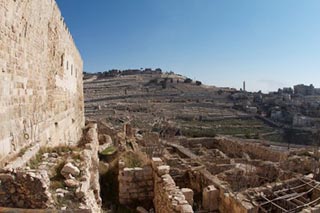9:1–34 In this passage, the Chronicler shifts from a mostly pre-exilic genealogy to a catalog of the returned exiles, but the list is almost completely devoted to information about returning priests and Levites (1 Chron 9:10–34), aside from the brief mention of some members of other tribes (vv. 3–9). The passage is substantially paralleled by Neh 11:3–19. |
9:1 the book of the kings of The Chronicler refers to this source several times (e.g., 2 Chr 27:7; 35:27). The exact nature of the source is unknown, but it most likely is not the same work as the biblical 1–2 Kings, which includes no such genealogies. Also, 1–2 Chronicles refers to this source in contexts for which 1–2 Kings gives no further information (compare 2 Chr 27:1–9; 2 Kgs 15:32–38).
on account of their sin The Chronicler attributes Judah’s exile to its unfaithfulness to the covenant with Yahweh (2 Chr 36:14; see note on 1 Chron 5:25).
9:3 lived in Jerusalem Similar material appears in Neh 11:4–9. Despite the reference to Ephraim and Manasseh here, the list of names in 1 Chron 9:4–9 and the comparable list in Neh 11:4–9 appear to refer only to returnees from Judah and Benjamin.
9:5 Shilonites Possibly a surviving clan from Ephraim, since Shiloh was a city of Ephraim located northeast of Bethel (Judg 21:19). The prophet Ahijah is called a Shilonite (1 Kgs 11:29; 2 Chr 10:15). However, the parallel reference to a Shilonite in Neh 11:5 connects to the tribe of Judah.
was a city of Ephraim located northeast of Bethel (Judg 21:19). The prophet Ahijah is called a Shilonite (1 Kgs 11:29; 2 Chr 10:15). However, the parallel reference to a Shilonite in Neh 11:5 connects to the tribe of Judah.
9:10–34 This list of religious workers closely aligns with the material from Neh 11:10–19. Both lists cover the same offices in the same order, identifying those who served as priests (1 Chron 9:10–13; Neh 11:10–14), Levites (1 Chron 9:14–16; Neh 11:15–18), and gatekeepers (1 Chron 9:17–27; Neh 11:19). |
9:22 by David and Samuel the seer The authorization for these Levitical families to serve as the official temple guards or gatekeepers goes all the way back to the time of King David and Samuel the prophet. Samuel’s early duties at the tabernacle might have involved serving as a guard to protect the sanctuary from defilement (1 Sam 3:1–3). The Chronicler generally refers to Samuel as “seer” (ro’eh), not “prophet” (navi; see 1 Chron 26:28; 29:29).
9:35–44 The Chronicler concludes his lengthy genealogical section (1:1–9:44) by repeating information from the genealogy of Saul |
9:39 Saul As Israel’s first king, Saul reigned from about 1051 to 1011 bc.
reigned from about 1051 to 1011 bc.

|
About Faithlife Study BibleFaithlife Study Bible (FSB) is your guide to the ancient world of the Old and New Testaments, with study notes and articles that draw from a wide range of academic research. FSB helps you learn how to think about interpretation methods and issues so that you can gain a deeper understanding of the text. |
| Copyright |
Copyright 2012 Logos Bible Software. |
| Support Info | fsb |
 Loading…
Loading…

